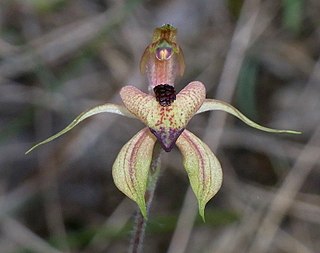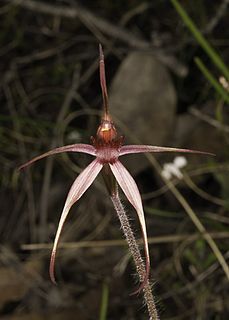Caladenia amoena, commonly known as the charming spider orchid, is a plant in the orchid family, Orchidaceae, and is endemic to Victoria. It is a ground orchid which grows singly or in small groups, has a single dark green, hairy leaf and a single yellowish-green flower with red stripes. It is only known from a few sites and has been classified as Endangered.

Caladenia arenaria, commonly known as the sand-hill spider orchid, is a plant in the orchid family Orchidaceae and is endemic to New South Wales. It is a ground orchid with a single, densely hairy leaf and one or two white or pale yellow flowers with maroon tips. Formerly much more widespread, it is now only known from about two thousand individual plants in five locations in the Riverina area and is classed as "Endangered".
Caladenia audasii is a plant in the orchid family Orchidaceae and is endemic to Victoria. It is a rare ground orchid with a single hairy leaf and a single yellow flower.
Caladenia brachyscapa is a plant in the orchid family Orchidaceae and is native to Victoria and possibly Clarke Island in Bass Strait. It is a ground orchid with a single hairy leaf and a reddish-pink flower with thick, black, club-like swellings on the petals and sepals. Although formally described in 1988 living specimens have not been observed since 1979.
Caladenia bryceana subsp. cracens, commonly known as the northern dwarf spider orchid, is a plant in the orchid family Orchidaceae and is endemic to the south-west of Western Australia. It has a single spreading, hairy leaf and a single green to apricot-coloured flower. It is a small orchid and difficult to find, even when quite abundant in a particular location. It has a more northerly distribution than subspecies bryceana which grows closer to Albany.

Caladenia cardiochila, commonly known as thick-lipped spider-orchid, fleshy-lipped caladenia and heartlip spider-orchid, is a plant in the orchid family Orchidaceae and is endemic to Victoria and South Australia. It is a ground orchid with a single hairy leaf and one or two yellowish-green, red-striped flowers on a thin, wiry stem.

Caladenia clarkiae, commonly known as pink caps, is a plant in the orchid family Orchidaceae and is endemic to south-eastern Australia. It is a ground orchid which grows singly or in small groups in Victoria and New South Wales. It has a single leaf and usually one or two white to pale pink flowers with darker pink tips.
Caladenia colorata, commonly known as coloured spider-orchid, small western spider-orchid and painted spider-orchid is a plant in the orchid family Orchidaceae and is endemic to South Australia and possibly Victoria. It is a ground orchid with a single hairy leaf, and usually a single creamy-green flower with blood-red or purple-brown markings and with dark tips on the petals and sepals.

Caladenia congesta, commonly known as black-tongue caladenia, is a plant in the orchid family Orchidaceae and is endemic to Australia. It is a ground orchid with a single, sparsely hairy leaf, and up to three bright pink flowers with the central part of the labellum completely covered with black calli. It is a widespread species but not common in any part of its range.

Caladenia filamentosa, commonly known as daddy-long-legs, is a plant in the orchid family Orchidaceae and is endemic to eastern Australia. It is a ground orchid with a single hairy leaf and up to four, usually dark red flowers with long, drooping lateral sepals and petals.

Caladenia flavovirens, commonly known as the summer spider orchid, or the Christmas spider orchid is a plant in the orchid family Orchidaceae and is endemic to Victoria in Australia. It is a ground orchid with a single hairy leaf and one or two pale greenish-yellow flowers.

Caladenia formosa, commonly known as the large crimson spider orchid, or elegant spider orchid is a plant in the orchid family Orchidaceae and is endemic to Victoria and South Australia. It is a ground orchid with a single hairy leaf and a single crimson-coloured flower and which mainly occurs only in south-western Victoria.
Caladenia hastata, commonly known as Mellblom's spider orchid is a plant in the orchid family Orchidaceae and is endemic to Victoria. It is a ground orchid with a single hairy leaf and up to three white to cream-coloured flowers with red markings on the labellum.
Caladenia leptoclavia, commonly known as the thin-clubbed spider orchid, is a plant in the orchid family Orchidaceae and is endemic to New South Wales. It is a ground orchid with a single hairy leaf and a single pale cream-coloured to yellow flower with dark reddish stripes.

Caladenia phaeoclavia, commonly known as the brown-clubbed spider orchid is a species of orchid endemic to New South Wales. It has a single, hairy leaf and a single light to dark green flower with red stripes and thick, brownish club-like tips on the sepals.

Caladenia rosella, commonly known as the rosella spider orchid is a plant in the orchid family Orchidaceae and is endemic to south-eastern Australia. It is a ground orchid with a single hairy leaf and a single scented pink flower. Although it may have had a wider distribution in the past, the total number of plants in 2000 was estimated to be 120 in four populations in Victoria. There is a single record from New South Wales but the orchid is classified as "extinct" in that state.

Caladenia tessellata, commonly known as the thick-lip spider-orchid, is a plant in the orchid family Orchidaceae and is endemic to south-eastern Australia. It is a ground orchid with a single hairy leaf and one or two yellowish-green flowers with dark red markings.

Caladenia versicolor, commonly known as the candy spider orchid, is a plant in the orchid family Orchidaceae and is endemic to Victoria. It is a ground orchid with a single, sparsely hairy leaf and one or two white, pink or purplish flowers. Only about one thousand plants in two populations have been recorded and the species has been declared as "vulnerable".
Caladenia branwhitei, commonly known as the Bethungra spider orchid, is a plant in the orchid family Orchidaceae and is endemic to southern New South Wales. It has a single dull green leaf and one or two, usually dark red to maroon-coloured flowers. It is only known from three areas near Bethungra where it grows in ironbark forest.

Caladenia orestes is a plant in the orchid family Orchidaceae and is endemic to an area in the south of New South Wales. It is a ground orchid with a single leaf and one or two cream-coloured to light reddish flowers. It grows in forest on hillsides around Burrinjuck.













